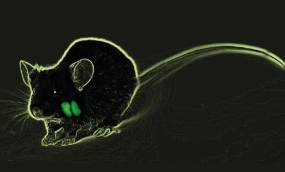Competition among cells prevents cancer
T lymphocytes arise from the thymus gland, which plays an important role in the immune system. In this organ, immature progenitor cells originating in the bone marrow mature into immune system cells. The bone marrow constantly produces new progenitor cells that migrate into the thymus, where they replace older, "worn-out" progenitors. Scientists at the German Cancer Research Center (Deutsches Krebsforschungszentrum, DKFZ) have now discovered that this competition between older and younger cells seems to be essential for the prevention of cancer. In its absence, experimental mice developed leukemia. The researchers presented their results in the latest issue of Nature.
The thymus gland is an organ about the size of a fist that lies behind the breastbone. It is a central component of the immune system and is the place where T lymphocytes develop into active immune system cells. Only those that are able to discriminate between "self" and "non-self" are allowed to leave the thymus and go on to eliminate infected or cancerous cells, while tolerating the body’s own tissues.
"Normally, progenitors of T cells migrate from the bone marrow into the thymus, where they mature, at regular intervals," says Hans-Reimer Rodewald, head of the Division of Cellular Immunology at the DKFZ. If the regular supply of progenitors from the bone marrow stops, the thymus is able to produce its own T cells for a few months. This is apparently due to the fact that the thymus hosts immature progenitor cells that renew themselves in the absence of supply from the bone marrow, and more T cells can mature from them. Presumably, this mechanism serves a necessary role as a "reservoir", ensuring that if the bone marrow experiences a problem, the production of essential immune cells won’t be interrupted. (DKFZ PR No. 38/2012)
This reservoir, however, is accompanied by a risk of developing cancer, as demonstrated in the recent study. Rodewald and his colleagues transplanted a healthy thymus into mice that had been genetically modified in a way that made their bone marrow incapable of producing lymphocyte progenitors. This meant that no immature progenitors were supplied to the thymus. After a couple of months, many of these mice developed T-cell leukemia. "We think that this is caused by the absence of cell-cell competition," says Rodewald. "A regular replacement of older progenitor cells in the thymus by younger ones from the bone marrow seems to be vital. This periodic exchange leads to competition between younger and older cells; if it fails to take place, the older cells mature into defective cells that easily undergo transformation into leukemia cells."
Vera Martins, first author of the publication, examined the young and the old progenitor cells for differences. "We found several genes whose activity differs in young and old cells." These included a gene that is an important trigger of leukemia in mice as well as humans. "Old progenitor cells strongly activated this gene if they were not replaced by younger cells," Martins reports.
How do the old progenitor cells sense that there are no younger competitors around? "We assume that growth factors control competition between the cells," Martins says. "Young cells seem to use these signals more effectively than their older counterparts and are thus better protected from cell death through apoptosis."
The T cell acute lymphoblastic leukemia (T-ALL) that developed in the mice exhibited genetic and cellular alterations that are similar to those found in human T-ALL, a cancer that occurs primarily in children. "We think that our findings provide a model to explain how this extremely aggressive childhood leukemia may develop," Rodewald explains. "Interestingly, there are reports in the literature saying that lymphoblastic leukemias in humans can develop several months after temporary failures of bone marrow whose causes are unknown. Until now, however, no link has been established between these two events."
The findings are also relevant for a small group of children who received gene therapy to treat a rare immune deficiency (SCID). This genetic defect prevented their bodies from producing T cells. This left them completely defenseless in the face of viral attacks, and they could only survive in isolation tents. When the children were treated with a type of gene therapy involving modified stem cells, the immune deficiency was cured and they could leave the isolation tents. However, five of the 20 children who had undergone the treatment developed T-ALL-type leukemia.
"We think that these blood cancers are also linked to the absence of competition in the thymus," says Rodewald. "We observed that the modified stem cells migrated into the thymus without settling in the bone marrow first. Therefore, these children were also lacking a supply of young progenitor cells from the bone marrow and the competition in the thymus gland. This state promotes the development of leukemia."
Vera C. Martins, Katrin Busch, Dilafruz Juraeva, Carmen Blum, Carolin Ludwig, Volker Rasche, Felix Lasitschka, Sergey Mastitsky, Benedikt Brors, Thomas Hielscher, Hans Joerg Fehling, and Hans-Reimer Rodewald. Cell competition is a tumor suppressor mechanism in the thymus. Nature (2014), DOI 10.1038/nature13317.
With more than 3,000 employees, the German Cancer Research Center (Deutsches Krebsforschungszentrum, DKFZ) is Germany’s largest biomedical research institute. DKFZ scientists identify cancer risk factors, investigate how cancer progresses and develop new cancer prevention strategies. They are also developing new methods to diagnose tumors more precisely and treat cancer patients more successfully. The DKFZ's Cancer Information Service (KID) provides patients, interested citizens and experts with individual answers to questions relating to cancer.
To transfer promising approaches from cancer research to the clinic and thus improve the prognosis of cancer patients, the DKFZ cooperates with excellent research institutions and university hospitals throughout Germany:
The DKFZ is 90 percent financed by the Federal Ministry of Education and Research and 10 percent by the state of Baden-Württemberg. The DKFZ is a member of the Helmholtz Association of German Research Centers.


